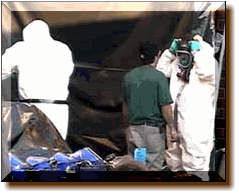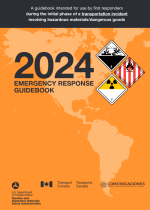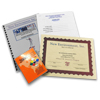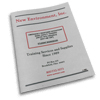 Home
Home
8-Hour First Responder Operations
Click to sign up forour E-Newsletter

Jump To Section
Regulation | Open Enrollment Seminars | Other Course Options | Individual Products
Open Enrollment Seminars
This class is not scheduled for any upcoming seminars. It is available for On-Site Training, Call or E-mail us to schedule a seminar.
Optionally, you can purchase the On-Site Training Seminar Kit below.
Course Regulation
29 CFR 1910.120:- (q)(6): Training. Training shall be based on the duties and function to be performed by each responder of an emergency response organization. The skill and knowledge levels required for all new responders, those hired after the effective date of this standard, shall be conveyed to them through training before they are permitted to take part in actual emergency operations on an incident. Employees who participate, or are expected to participate, in emergency response, shall be given training in accordance with the following paragraphs:
- (q)(6)(ii): First responder operations level. First responders at the operations level are individuals who respond to releases or potential releases of hazardous substances as part of the initial response to the site for the purpose of protecting nearby persons, property, or the environment from the effects of the release. They are trained to respond in a defensive fashion without actually trying to stop the release. Their function is to contain the release from a safe distance, keep it from spreading, and prevent exposures. First responders at the operational level shall have received at least eight hours of training or have had sufficient experience to objectively demonstrate competency in the following areas in addition to those listed for the awareness level and the employer shall so certify.:
- Knowledge of the basic hazard and risk assessment techniques;
- Know how to select and use proper personal protective equipment provided to the first responder operational level;
- An understanding of basic hazardous materials terms;
- Know how to perform basic control, containment and/or confinement operations within the capabilities of the resources and personal protective equipment available with their unit;
- Know how to implement basic decontamination procedures;
- An understanding of the relevant standard operating procedures and termination procedures.
The Following Topics are Covered in this Course
- Regulatory Overview
- Hazardous Substance Response
- Hazardous Substance Identification
- Emergency Response Preparedness
- Personal Protective Equipment
- Decontamination
- Site Control
- Hazardous Substance Definitions
- Local Emergency Response Plan
- Course Review / Final Test


Other Course Options
Seminar Kits for Instructors
$495.00 Add To Cart

Class Hours: 8
Regulation: 29CFR 1910.120 (q)(6)(ii)
- 1 - Easy to Use Color Instructor Lesson Plan
- 10 - Student Workbooks
- 10 - Student Tests
- 10 - Student Certificates
- 10 - DOT Emergency Response Guidebooks
- 1 - Course PowerPoint® with Regulations
- 2 - Course Video's FREE (a $100.00 value)
- Chemical Safety Board videos
$35.00 Add To Cart

Additional student packs can be purchased to include:
- 1 - Student Workbook
- 1 - Student Test
- 1 - DOT Emergency Response Guidebook
- 1 - Course Certificate
Online Couse Options
$75.00 Add To Cart

Prerequisite:
None
Class Hours:
8
Regulation(s):
29CFR 1910.120 (q)(6)(ii)
Course Code:
FRO-OL
Course Description
This online instructional program is intended to help fulfill the training requirements for Emergency Response Operations. As with any online training program, site specific hazards and procedures should be reviewed by enrollees of this program.
Our program is intuitive and easy to use for yourself and your employees. Order for your entire department and use our automated invitation program to send registration codes to each individual in your department.
As always you will receive the same product and content support as you have come to expect from New Environment, Inc. Professional Confined Space instructors are standing by to answer your questions and concerns before, during and after the completion of your training.
Course Regulation
29 CFR 1910.120:- (q)(6): Training. Training shall be based on the duties and function to be performed by each responder of an emergency response organization. The skill and knowledge levels required for all new responders, those hired after the effective date of this standard, shall be conveyed to them through training before they are permitted to take part in actual emergency operations on an incident. Employees who participate, or are expected to participate, in emergency response, shall be given training in accordance with the following paragraphs:
-
(q)(6)(ii):
First responder operations level. First responders at the operations level are
individuals who respond to releases or potential releases of hazardous substances
as part of the initial response to the site for the purpose of protecting nearby
persons, property, or the environment from the effects of the release. They are
trained to respond in a defensive fashion without actually trying to stop the
release. Their function is to contain the release from a safe distance, keep
it from spreading, and prevent exposures. First
responders at the operational level shall have received at least eight hours of
training or have had sufficient experience to objectively demonstrate competency
in the following areas in addition to those listed for the awareness level and
the employer shall so certify.:
- Knowledge of the basic hazard and risk assessment techniques;
- Know how to select and use proper personal protective equipment provided to the first responder operational level;
- An understanding of basic hazardous materials terms;
- Know how to perform basic control, containment and/or confinement operations within the capabilities of the resources and personal protective equipment available with their unit;
- Know how to implement basic decontamination procedures;
- An understanding of the relevant standard operating procedures and termination procedures.
View the online course requirements on our Online Courses Page.
On-Site Training
New Environment, Inc. offers On-Site Training for this course, call or E-mail us to schedule this course.
Individual Products
Instructor Materials
$125.00 Add To Cart

The Following Topics are Covered by this Course
- Regulatory Overview
- Hazardous Material Classes
- Loading And Unloading
- Segregation Charts
- Hazardous Material Compliance Pocketbook
- 704 Marking System
- Hazard Communication Standard
- Elements Of A Safety Data Sheet
- The Emergency Response Guidebook
- Personal Protective Equipment
- Basic Site Control Procedures
- Decontamination Procedures
- Hazardous Material Terminology
- Course Review And Final Test
$125.00 Add To Cart
 Fully editable PowerPoint presentation for 8-Hour First Responder Operations
Fully editable PowerPoint presentation for 8-Hour First Responder Operations
Student Materials
$29.00 Add To Cart

Student Material Includes:
- Student Background Survey
- Student Classroom Workbook
- 20 Question Test
- Certificate Of Completion*
- Participant Evaluation Form
$6.00 Add To Cart

This Guidebook is primarily a guide to aid first responders in quickly identifying the specific or generic hazards of the material(s) involved in the incident, and protecting themselves and the general public during the initial response phase of the incident.
The Emergency Response Guidebook is updated every three to four years to accommodate new products and technology.
Use this DOT-issued guidebook to help you satisfy DOT's requirement that Hazmat shipments be accompanied by emergency response information (49 CFR Section 172.600).
View the 2024 Emergency Response Guidebook Summary of Changes from 2020.
Published by the U.S. Department of Transportation. 4"x5.25" Pocket Version